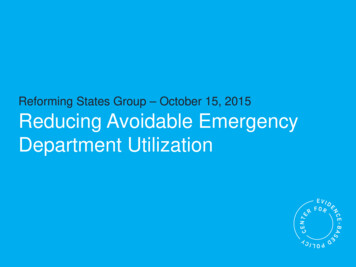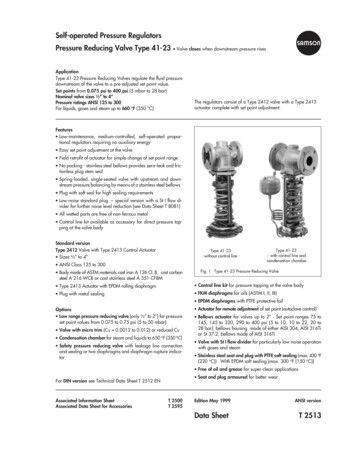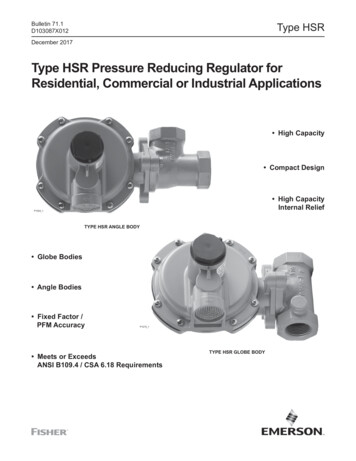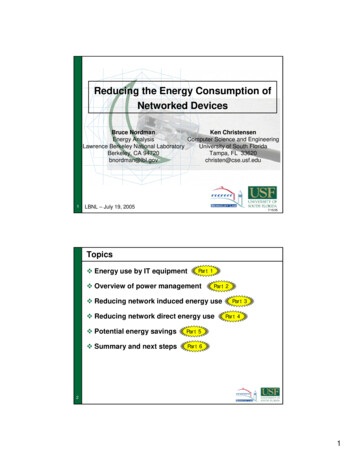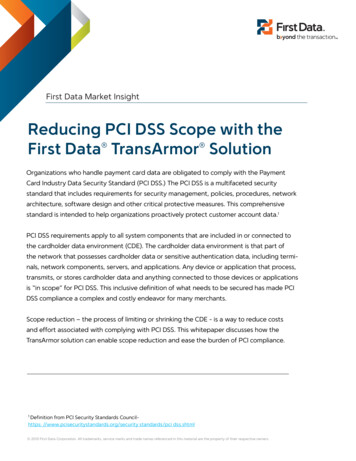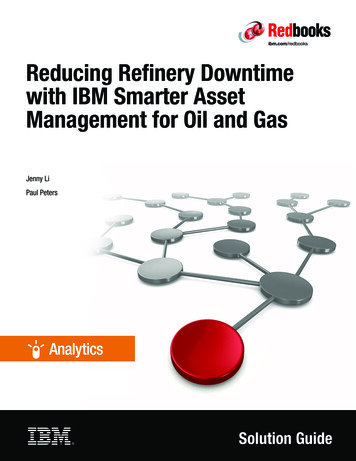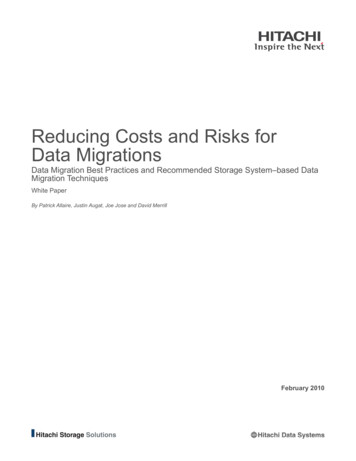
Transcription
Reducing Costs and Risks forData MigrationsData Migration Best Practices and Recommended Storage System–based DataMigration TechniquesWhite PaperBy Patrick Allaire, Justin Augat, Joe Jose and David MerrillFebruary 2010
Executive SummaryForrester 2007 research has shown that in excess of 70 percent of enterprise IT budgets isdevoted to maintaining existing infrastructure. Organizations need to accelerate innovationand reduce operating expenses to increase their competitiveness or maintain their currentmarket position, CIOs are under pressure to identify and adopt best practices to lower theirIT operating expenses and redirect the savings in support of new investments.Major drivers of growing data center operating expenses include ongoing power, coolingand labor costs. IT organizations are in a constant flux, handling change management dueto storage growth, consolidations, mergers and acquisitions, vendor product life cycles,and interoperability and supportability requirements. For example, most enterprise IT shopshave to plan for their storage platforms’ end of life and migration before the end of the fourto five years of the storage product’s useful life. This white paper is intended to provide ITdecision makers with information on costs, risks and considerations regarding the migrationof data from old storage platforms to new storage to reduce this significant area of operatingexpenses.To understand the strategies and best practices organizations were using to reduce costand risk with storage migration, Hitachi Data Systems sponsored a survey in partnershipwith TechValidate, an independent market research firm. Key findings from the survey thatillustrated the expense of migration and best practices to reduce the cost and risk include:yyMigration project expenditures are on average 200 percent of the acquisition cost ofenterprise storage. With an average of four years useful life, the annual operatingexpenses associated to migration represent 50 percent of acquisition cost.yyEnterprise storage migration costs can exceed US 15,000 per terabyte migrated.yyStorage migration projects required four to six hours per host, from internal organizationresources. Of these hours, four to five hours were used to plan the migration and one totwo hours ( 30 percent) were used to execute the migration.yyDuration of the migration is mainly due to limited maintenance windows. Commonmigration techniques require application outages due to either SAN rezoning and/or hostreboot activities.yyThe two biggest concerns that organizations face during a data migration are the risk ofdowntime or extended downtime/impact to the business and the budget overrun of themigration project. Seventy percent of customers reported schedule overruns of about 30percent while 64 percent reported average budget overruns of 16 percent.yyThe leading indicator of schedule and budget overruns was the team member experience.
Organizations are spending considerable resources and assuming more risk than necessaryto conduct data migrations. There are many new approaches using virtualization that greatlyreduce cost and risk. To successfully migrate data with these new approaches, enterpriseIT executives should leverage a vendor who understands the all of the approaches and hasexperience migrating various platforms with multiple technologies. Hitachi Data Systemshas a broad portfolio of hardware, software and services and has experience with all industry leading software and hardware to help organizations reduce risk and costs for their datamigrations now and for the future. Also, with emerging technologies such as Hitachi HighAvailability Manager software, which enables storage controller–based migration, organizations will be able to completely eliminate the outage window due to data migrations.By reducing risk and costs for data migrations, organizations will reduce operating costsdue to data migrations and more easily prevent technological obsolecence. Enterprise ITexecutives should use the ideas in this paper to research this topic further to understandhow much data migration costs their organization. These costs will only increase. HitachiData Systems expects the industry average cost of enterprise storage migration to continueto rise due to increasing 24/7 application availability requirements and increases in cost oflabor. On the basis of this research, it is highly recommended that IT executives evaluatenew storage platforms in conjunction with migration solutions to lower data center operatingexpenses.For best results use Acrobat Reader 8.0
ContentsThe Importance of Data Migration.1Description of Enterprise Storage Migration Survey.2Unexpected or Extended Downtime: Organizations Always Need to HaveTheir Information . 3Schedule Overrun: IT Project Management . . 4Budget Overrun. 4Key Cost Factors for Data Migration.5Change Control/Remediation. 5Server/SAN Outage Cost. 6Application Outage Cost. 7Labor for Data Movement/Migration. 7Specialized Hardware and Software for Migration. 7Added Environmental Costs. 8Useful Life Impact on Storage System. 8Storage System Maintenance. 8Combining People, Processes and Technology to Reduce Data Migration Cost and Risk .8Storage Virtualization Approach. 10Cost of Migration Comparison .11Best Practices and Lessons Learned from Successful Data Migrations. 15Conclusion: Develop Comprehensive Strategy to Reduce Both Cost and Risk.16Appendix A — Survey Demographics.17Appendix B — Calculation of Data Migration.20Appendix C — Survey Results: Direct Costs.22Appendix D — Cost Analysis.24Appendix E — Survey Results: Best Practices from Successful Data Migrations.25Appendix F — Hitachi Data Systems Data Migration Methodology.26
Reducing Costs and Risks forData MigrationsData Migration Best Practices and Recommended Storage System–basedData Migration TechniquesWhite PaperBy Patrick Allaire, Justin Augat, Joe Jose and David MerrillThe Importance of Data MigrationData Migration is an important event that consumes significant budget and labor and occurs very regularly. Thecombination of the frequency of and resources consumed in a data migration results in data migration taking asignificant amount of the IT budget. As storage infrastructures become larger and more complex, data migrations are becoming more complex, risky and labor intensive. Organizations must begin managing this growingportion of their IT budgets more effectively.According to a 2005 survey conducted by ESG, data migration projects are constantly being conducted byIT managers: “Attesting to the fact that data migration is a fact of life for the IT manager, 39 percent of thosesurveyed said that they perform migration on a weekly or monthly basis.” While organizations are continuallymigrating data, they are not considering data migrations a core competency as data migration is usually theresult of another event in the data center, such as an application upgrade, data center consolidation project ortechnology refresh. According to Gartner:Interest in data migration and conversion risks and best practices is on the increase as a result ofcontemporary business drivers, including a mandate for IT modernization (replacing legacy, riskyand non-strategic technology) and cost optimization (reducing the cost of IT through consolidationand efficiency improvement). Gartner client inquiry trends clearly reflect this, with the volume ofinquiries about data migration issues and practices up more than 50 percent in 2008, compared to2007.— Gartner, “Risks and Challenges in Data Migrations and Conversions,” February 2009, ID Number: G00165710Data migration projects can be very complex, large scale projects requiring many in-house and contractorpersonnel. As a result, the labor, consulting, software and hardware for data migration have become a verylarge market. The overall market for data migrations can be calculated by identifying amount of data migrationactivity that results in large data migrations. Many data migrations are a result of technology refreshes. Forexample, an average FORTUNE 1000 company has an average of 800TB of network attached storage (NAS)and nearly 3PB of storage (InfoPro Wave 12–Q2, 2009) with, on average, 300TB per storage system. As theuseful life of most storage systems is three to five years, this size of organization will often, at any given time,have multiple storage systems at the end of their useful life spans and requiring a refresh. Therefore, theselarge enterprises could be in a position where they would be always conducting a data migration of multiplestorage devices at any given time.We can assess the overall market for data migrations as a result of these storage technology refreshes byusing the overall storage market revenue forecast at US* 7.5 billion in 2009 (for storage systems 150,000)and data from our survey. Data from our survey indicated that when all the labor, resources and equipment required for conducting a data migration are included, the cost of the data migration was twice that of the acquisition price. Therefore, the overall data migration market would be 15 billion in operating expense to support*All monetary figures in this document are provided in US dollars.1
storage technology refresh in 2009. This type of market size indicates a very large operating expense; organizations should focus more attention on defining best practices and technology to reduce this large expense.Description of Enterprise Storage Migration SurveyIn all cases, the statistics and numbers referenced in this document should not be use in a rigid ways; thereader should look at these findings as an industry average, which fluctuates based on sampling frame.Changes in size of organization respondent, industry, geographic location, and labor cost and migration technique selected are just examples of factors which influence migration project statistics. Due to the fact thatHitachi Data Systems did not force an equal sample of respondents for each migration technique, comparisonsbetween migration technique (as shown in Figure 1) are limited to host and virtualization migration techniquesonly; the number of observations was too low for the other techniques to make a valid comparison.Figure 1. Migration Technique UsedIn the sampling frame for this research were respondents who have storage responsibility (from CIO to storageadministrator) and were part of an enterprise organization ( 1,000 employee US companies, 500 employeenon-US-based organization); 50 percent were Hitachi Data Systems customers and 50 percent were nonHitachi Data Systems customers. The respondent organizations needed to be located within countries thatwere English (reading) proficient (for example, United States, Canada, UK, Germany, Switzerland, Belgium,Australia, New Zealand, Singapore, etc).Respondents' industries and sizes of migration projects (in terms of size of data set migrated, number of storage frames and number of hosts impacted) were widespread. For a detailed breakdown of respondents, go toAppendix A — Survey Demographics.Considering that respondents reported in excess of 70 percent of the storage migration cost is driven by laborcost, it is important to factor in the full time equivalent (FTE) costs reported in this research of 126,000 incontrast with IT average labor cost for an industry or organization. FTE cost does not equal employee salary;frequently, an organization’s FTE cost may be closer to a ratio of 1.25 to 1.5 times the employee salary.This salary-to-FTE ratio varies based on organization overhead and geographic disparity in social benefits.For a more detailed breakdown of the wide range of reported FTE cost please go to Appendix A — SurveyDemographics.2
Key Risk Factors for Data MigrationsData migration projects are critical to the success of the initiatives that the migrations support; they impactbusiness critical data, applications and systems, and result in significant cost. The data migration project itselfpossesses significant risks and requires proper planning and attention to ensure success of the data migration and the initiatives that it supports, which could be an enterprise-wide application upgrade, a data centerconsolidation or an infrastructure upgrade.However, as Gartner indicates, many organizations do not place the proper importance on and take properconsideration of the data migration:Analysis of data migration projects over the years has shown that they meet with mixed results.While mission-critical to the success of the business initiatives they are meant to facilitate and support, lack of planning structure and attention to risks causes many data migration efforts fail.— Gartner, “Risks and Challenges in Data Migrations and Conversions,” February 2009, ID Number: G00165710In our survey research, survey participants identified many risks for data migration projects, as indicated inFigure 2.Figure 2. Perceived Risks in the Migration PlanningWe will focus on a few key areas of risk for data migrations: downtime or loss of data, schedule overrun, budget overrun and customer/brand impact.Unexpected or Extended Downtime: Organizations Always Need to HaveTheir InformationVery detailed and careful planning needs to take place to clearly identify windows in which downtime is acceptable and ensure that no data is lost. For data migration projects that include mission critical business data, therisk of impacting sales operations is high; the loss of availability or access to the data could directly impact theprofit and loss of the business.Trends in compute architectures and the adoption of virtualization have increased the number of applicationsrunning on a single host. This has resulted in decreasing maintenance windows where the downtime to a hostcan result in multiple significant application outages. Figure 3 illustrates the increasing density of applicationsdue to virtualization and adoption of multicore computing architectures.3
Figure 3. Increasing Application DensitySchedule Overrun: IT Project ManagementAccording to the participants in our survey, only 64 percent of data migration projects were completed within10 percent of the planned date. When data migration projects last longer than planned, resources are used forlonger than anticipated. The schedule overrun can also impact or delay other planned IT projects and impactthe business. Often data migration is part of a larger overall project, and the delay in the data migration projectaffects the success of the larger overall project.Budget OverrunAs with all IT projects, a significant risk is the cost associated with any budget overrun. This can directly affectbudgeting for other IT projects and affect the profit-loss statement for the business. As identified previously,data migrations are part of a larger project. The budget overrun of the data migration project reduces the overall cost/benefit for the larger overall project.Customer/Brand ImpactData migration projects can involve customer business data. If any of that data is lost or a customer’s accessto the data is interrupted, there could be very severe negative public relations impact. The trend for organizations to have more interconnected applications between customers, suppliers and partners, where downtime inone application affects multiple applications, increases the magnitude of the negative impact of a loss of dataor availability of data. Also, there could be legal implications and revenue impacts for the loss of data or availability of data.Government Organization Migrating to a New Virtualized, Multitier EnvironmentSituation Migrating 60 servers with 47TB from an HP XP 1024 system to a Hitachi Universal Storage Platform VSolution Virtualized existing storage with Universal Storage Platform V technology and remotely replicate data Initiated replication in both directions and migrated single tier to three tiersKey Migration Challenges Overcome Required combination of host-based and virtualization methods Involved two separate migration windows and two sets of procedures Comprehensive plan addressed multiple host-based migration methods; a difference in migration speed was seen, with thevirtualized storage approach at 1TB/hr per server and the host-based method at 4hr/TB4
Key Cost Factors for Data MigrationStorage Economics from Hitachi Data Systems is a methodology to identify, isolate, characterize and measurecosts (of storage) so that actions can be taken to reduce total costs. Within these methods, Hitachi DataSystems has defined 33 different types of costs that apply to storage total cost of ownership (TCO).Some costs are hard costs, which means they directly impact budgets and expenditures. An example of a hardcost would be power and cooling costs for storage systems. This is a real cost that appears in the IT organization to provide power. Soft costs, on the other hand, are those that are quantifiable but may not producetangible results in a budget. Reducing a storage management action may save an administrator two hours ofwork, and although the savings of two hours has many benefits, the administrator would not be paid any lessdue to this change.Storage costs are also highly dependent on the organization that pays for the cost. Not all costs are simplyrolled into a single management budget. Rather,
and efficiency improvement). Gartner client inquiry trends clearly reflect this, with the volume of inquiries about data migration issues and practices up more than 50 percent in 2008, compared to 2007. — Gartner, “Risks and Challenges



